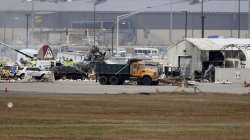With 13 onboard, World War II-era bomber crashes and burns at Hartford airport in aborted takeoff
A World War II-era B-17 bomber carrying 13 people crashed and burned at the Hartford airport in an aborted takeoff attempt Wednesday, killing an undetermined number of those aboard, authorities said.

A World War II-era B-17 bomber carrying 13 people crashed and burned at the Hartford airport in an aborted takeoff attempt Wednesday, killing an undetermined number of those aboard, authorities said.
The four-engine, propeller-driven plane struggled to get into the air and slammed into a maintenance shed at Bradley International Airport as the pilots circled back for a landing, officials and witnesses said.
It had 10 passengers and three crew members, authorities said.
Connecticut Public Safety Commissioner James Rovella said hours after the crash that some of those on board suffered severe burns and that it was too soon to say how many died.
“The victims are very difficult to identify,” Rovella said. “We don’t want to make a mistake.”
At least six people were taken to the hospital; their condition was not immediately disclosed.
The retired, civilian-registered plane was associated with the Collings Foundation, an educational group that brought its Wings of Freedom vintage aircraft display to the airport this week, officials said.
“Right now my heart really goes out to the families who are waiting,” Gov. Ned Lamont said. “And we are going to give them the best information we can as soon as we can in an honest way.”
The plane was a few minutes into the flight when pilots reported a problem and said it was not gaining altitude, officials said. It lost control upon touching down and struck the shed.
One person on the ground was injured, officials said. The airport _ New England’s second-busiest _ was closed after the crash.
Flight records from FlightAware shows the plane went down about five minutes after it took off. The data shows it had traveled about 8 miles (13 kilometers) and reached an altitude of 800 feet (244 meters).
Brian Hamer, of Norton, Massachusetts, said he was less than a mile away when he saw a B-17, “which you don’t normally see,” fly directly overhead, apparently trying to gain altitude but not succeeding.
One of the engines began to sputter, and smoke came out the back, Hamer said. The plane made a wide turn and headed back toward the airport, he said.
“Then we heard all the rumbling and the thunder, and all the smoke comes up and we kind of figured it wasn’t good,” Hamer said.
Antonio Arreguin said he had parked at a construction site near the airport for breakfast when he heard an explosion. He said he did not see the plane but could feel the heat from the fire, about 250 yards away.
“I see this big ball of orange fire, and I knew something happened,” he said.
Only a few of the roaring Boeing B-17s are still airworthy. They were critical in breaking Nazi Germany’s industrial war machine during World War II.
The Collings Foundation said that the same plane in Wednesday’s accident also crashed in 1987 at an air show near Pittsburgh, injuring several people. Hit by a severe crosswind as it touched down, the bomber overshot a runway and plunged down a hillside. It was later repaired.
The B-17 was built in 1945, too late for combat in World War II, according to the foundation.
It served in a rescue squadron and a military air transport service before being subjected to the effects of three nuclear explosions during testing, the foundation said. It was later sold as scrap and eventually was restored. The foundation bought it in 1986.
“This is kind of shocking. It’s a loss to lose a B-17,” said Hamer, whose father served in the Air Force. “I mean, there aren’t very many of those left.”